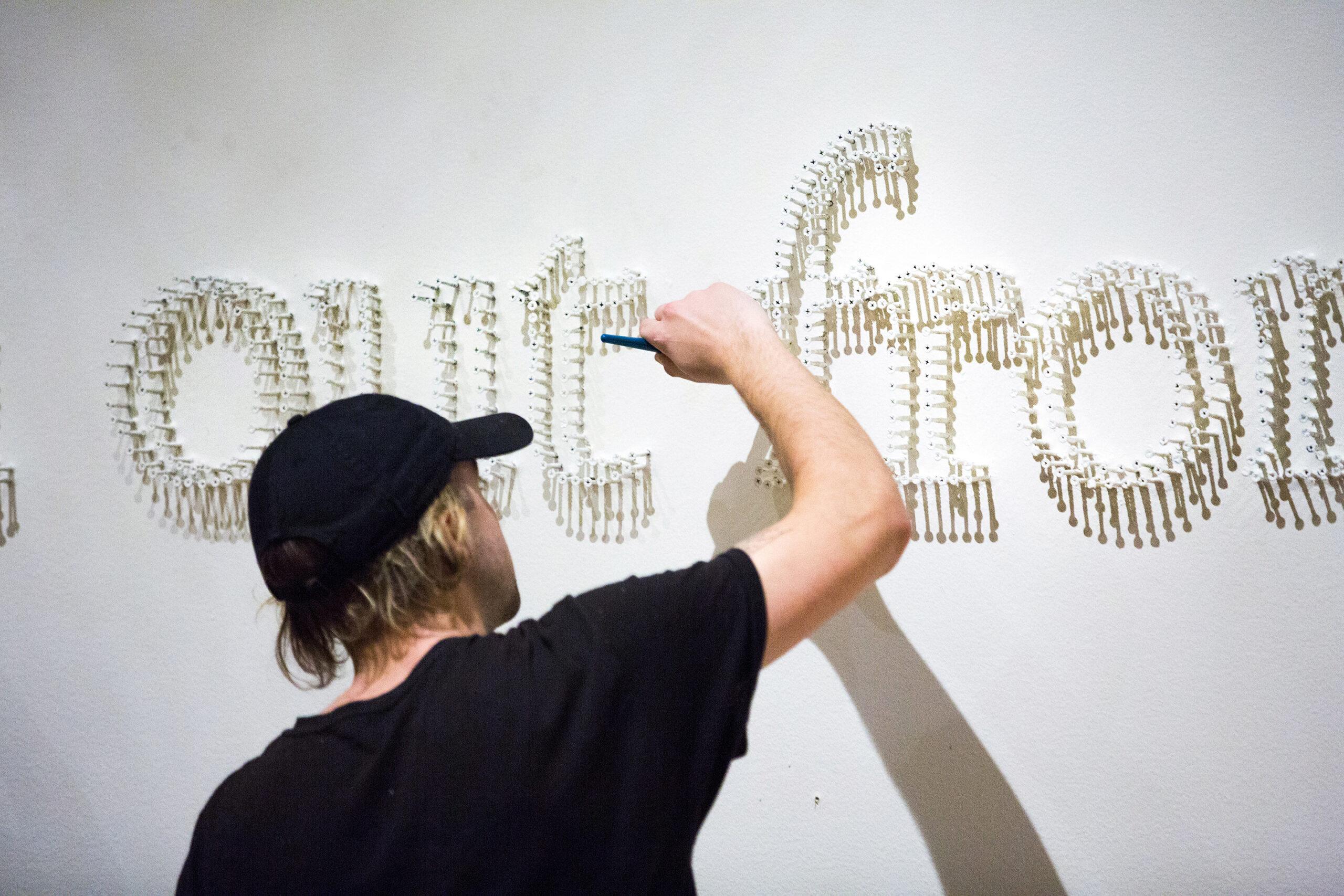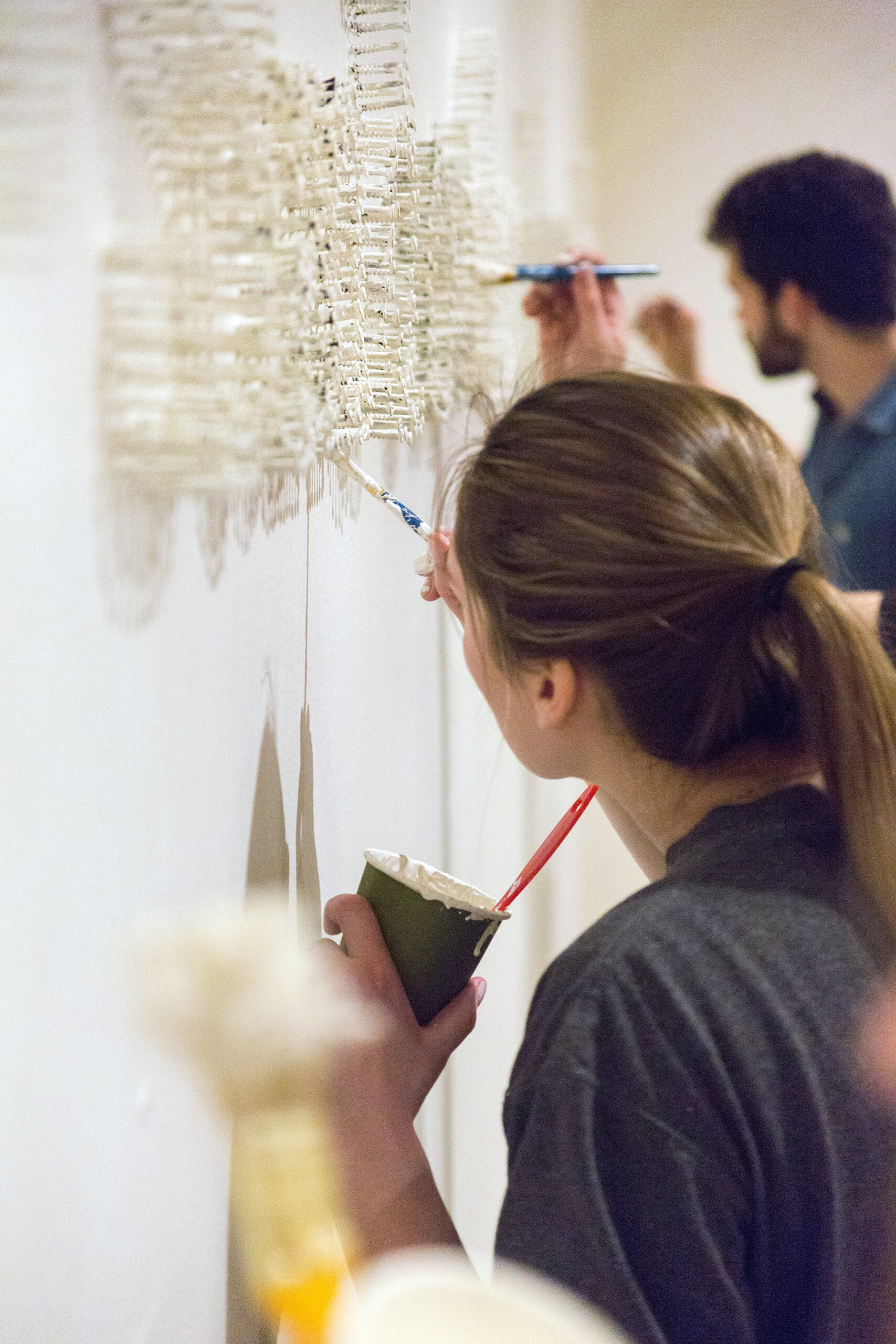Graphite and collaboration: drawing on the walls with Tony Lewis
February 23, 2018
 PJ Seelert
PJ SeelertIt took 15 students, 20 hours, 25 pounds of drywall screws, 7,000 rubber bands and the vision of Chicago-based artist Tony Lewis to create the unconventional drawings soon to be on display in the Bowdoin College Museum of Art.
Over the course of four days, students worked quietly side by side, wearing masks over their mouths and noses, drilling screws into the museum walls, painting them and stretching graphite-coated rubber bands around them. The process, overseen by Lewis and Andrew W. Mellon Postdoctoral Curatorial Fellow Ellen Tani, culminated in two wall drawings: the phrase “stand out from the crowd” and a more abstract piece called “Rubber.” The two works will be on display in Tani’s exhibition, “Second Sight: the Paradox of Vision in Contemporary Art,” which opens on Thursday.
Lewis views his process as a method of drawing.
“One of the most basic principles of drawing is pencil and paper,” said Lewis. “I think what I’ve done over the past few years is tried to just stick to that, but how can I blow up the idea of paper? How can I blow up the idea of graphite?”
The phrase Lewis decided to represent for Tani’s upcoming exhibition came from a volume called “Life’s Little Instruction Book”—a popular collection of advice and aphorisms Lewis found in his home that has inspired his work for many years.
“Who is this book really talking to? Who is it for? Is it for me? Sometimes. But there are a lot of instances that it’s not for me,” said Lewis. “And there’s something about [the fact] that that kind of book can creep into a safe space like the home and command that much authority.”
Lewis, with input from Tani, chose “stand out from the crowd” in order to encourage scrutiny and interpretation of a well-known phrase.
“This particular [phrase] stood out because of its reference to invisibility—invisibility as a choice, as a sort of privilege,” said Lewis.
“[The piece] offers you so much by saying so little,” said Tani. “But when you twist it in your head, you have to ask, ‘who is that person who can afford to be an individual? Are there certain people in this world who, because of their bodies or the way they occupy space, already [stand] out in the way that the author of this text is taking for granted?’ That’s the structure of thinking and dialogue that his work opens up that I really enjoy and appreciate. It’s my role, a challenging role as a curator, to frame the work in a way that allows us to access that meaning that’s beneath the surface.”
The installation also challenges viewers to consider identity in a more complex way.
“I’m inherently interested in work by artists of color that doesn’t illustrate race or doesn’t make any didactic representational claims to the black experience, or the Asian American experience, or the Latinx experience,” said Tani. “What that does to the conversation around race is make race more opaque than it is, and when you think about the structures of inequality and structures of disempowerment, these are pervasive, invisible forces that act on our lives so we don’t even know that we are inhabiting them when we’re acting in them.”
The other wall drawing takes the form of a character in Greggs shorthand, a stenographic system of writing designed to record the spoken word. The character Lewis chose stands for the word “rubber,” in an attempt to draw attention to the process of drawing itself.
“So it’s basically an opportunity to kind of write whatever I want or say whatever I want as opposed to being limited to another person’s language,” said Lewis. “For me, this is actually a very simple, joyful sort of mark.”


Comments
Before submitting a comment, please review our comment policy. Some key points from the policy: